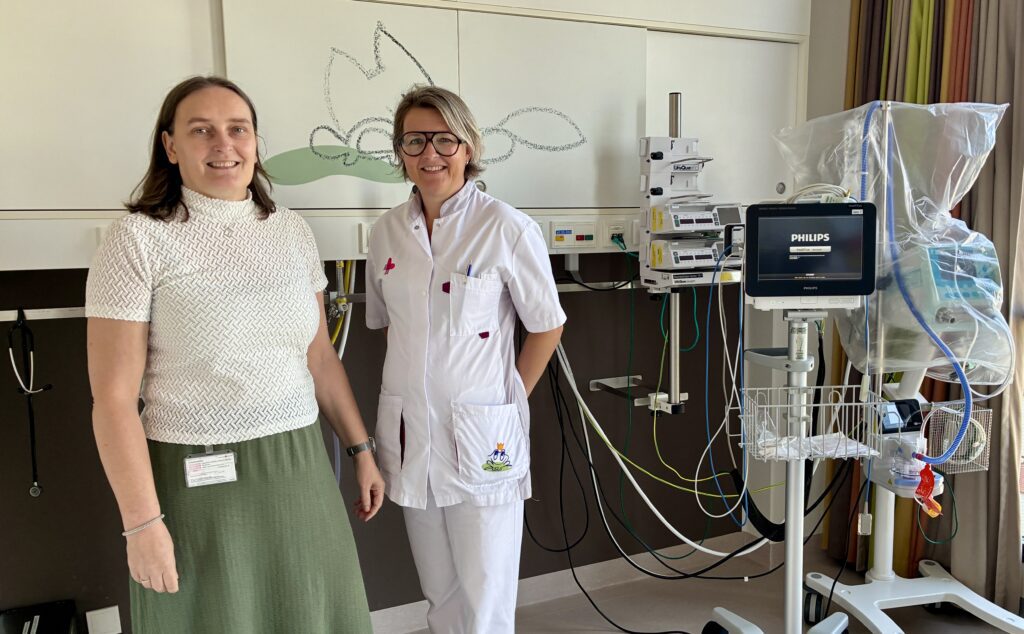It’s about taking back control. Fewer alarms, but the right ones in the right place. Because very important alarms deserves to be heard.
Bianca van der Veen, Medical Technology Advisor, Jeroen Bosch Hospital, ‘s-Hertogenbosch, The Netherlands

For years, the neonatal and pediatric ward of the Jeroen Bosch Hospital (JBZ) was filled with a constant stream of beeps and alerts: ranging from critical warnings to non-urgent notifications. Every alarm sound demanded attention. “Alarm fatigue creeps in gradually,” says Sanne Scheepens, coordinating nurse of the neonatal ward. “It only really becomes a topic of discussion when an incident occurs. But in the meantime, those sounds have a huge impact on our work, and on the recovery of the children.”
The effects of alarm fatigue were clear: nurses felt constantly interrupted in their work, parents experienced stress from the continuous noise, and children had less rest. Awareness grew that things needed to change — only the clinically relevant alarms should demand attention.
A thoughtful approach
JBZ chose a medical alarm system from CLB, with a central role for the Medical Device Data Gateway (MDDG) from itemedical. This technology connects bedside medical devices to nurses’ smartphones. Intelligent filtering and delay ensure that only relevant alarms come through. In this way, safety is guaranteed — and peace is restored.
“Our goal was clear,” explains Bianca van der Veen, advisor. “We wanted to create calm on the ward without compromising patient safety. By working with data — on alarm frequency, types of notifications, and priorities — we were able to make very targeted choices in how the system was configured.”
From pilot to rollout
The neonatal ward served as a pilot department. The new system was first implemented there, accompanied by an intensive process of testing, adjusting, and evaluating. “We really looked at what worked, what didn’t, and how colleagues and parents responded,” says Sanne. The results were positive: the alarm load decreased, the atmosphere improved, and nurses could better focus on patient care. The success led to a broader rollout — first to the pediatric ward, then to the pulmonary department — each time refined using department-specific data and feedback.
Nurses once again have the space to truly be present with their patients, without interruption from constant beeping.
Data as a compass
The MDDG plays a key role. The system vendor-independently connects all medical devices around the patient’s bed and collects vital parameters, alarm data, settings, and service notifications. Through operational dashboards, departments gain insight into their own situation, tailored to their specific needs. Each team can see exactly where the greatest improvements can be made. Bianca: “As an advisor, this is extremely valuable. You can precisely analyze where noise occurs in the system, which alarms go off too often, and how we can optimize settings. Without this data, you rely much more on gut feeling and assumptions. Now we can make well-founded, safe decisions.”
The change is not only technically noticeable, but also felt on a human level. Sanne observes that nurses feel less rushed: “They once again have the space to truly be present with the person they’re caring for, without constantly having to leave the room to silence alarms elsewhere. That means fewer unnecessary walking movements, more satisfaction — and more calm in care.”
Calm for both child and parent
Parents notice the difference too. The calmer environment gives them confidence that their child is recovering in a safe and peaceful setting. “You can tell that a quieter room also leads to calmer conversations with parents,” Sanne adds. “They feel more heard, because we’re less distracted.”
Continuous improvement with data
The system also encourages a culture of improvement. Using the available data, the team independently initiates new projects for a more pleasant work environment — with fewer stimuli for both nurses and patients. “An unexpected but welcome side effect,” adds Sanne.
Collaboration as a success factor
The success of the project lies in the close collaboration between healthcare staff, technical teams, and external partners. Implementation was carried out step by step, with room for adjustments. “It’s truly a multidisciplinary process,” emphasizes Bianca. “You need the practical knowledge of nurses to understand what works in daily care, and the technical expertise to configure it safely and effectively.”
Inspiration for hospitals
Sanne and Bianca are convinced: other hospitals can also benefit from this approach. For care teams, it means less alarm fatigue and more focus on the patient. For biomedical engineers, MICT, or clinical physicists, it demonstrates how data-driven care directly contributes to safer, higher-quality healthcare
Practical tips from experience
“Start by measuring,” advises Bianca. “Without data, you don’t know where to intervene. And involve the people who work with the alarms from the very beginning — they know exactly where the pain points are.”
Sanne adds: “Dare to look critically at your own workflow. Once you see what it brings to keep only the truly important alarms, you’ll never want to go back.”
In conclusion
For Sanne and Bianca, the conclusion is clear: technology, data, and collaboration together create a calmer, safer, and more human-centered care environment. From a stimulus-heavy ward to a quieter space with regained control — it’s a journey that begins by listening to the people on the floor and making smart use of data.
As Bianca summarizes: “It’s about taking back control. Fewer alarms, but the right ones in the right place. Because very important alarms deserves to be heard.”